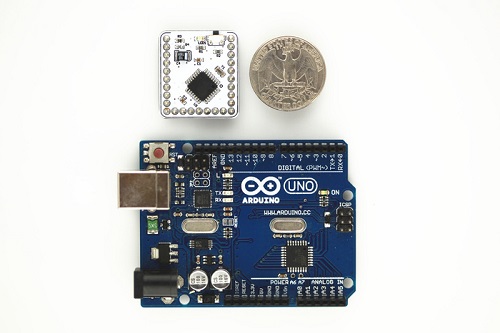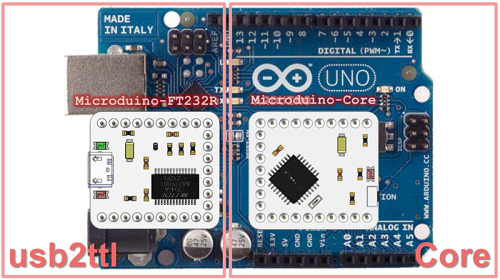The Microduino comes from a future world where computer hardware is constructed in miniature, streamlined, cube-like interchangeable components that are easily swapped in and out with little effort and absolutely zero grotesque wiring. And while Microduino is neither cube-like nor actually from the future, it’s a stackable, coin-sized, Arduino compatible, open-source hardware.

Microduino splits the Arduino Uno into two separate functional parts, allowing users to include the controller core and/or the communication core as needed. The Microduino-Core assembly is an Arduino minimum system board and the Microduino-FT232R is used for the signal communication between the PC and controller core.
Stackable
The device is not a development-board in and of itself, but a series of stackable modular components that function as an Arduino Uno (and its various shields) when combined. Why does this matter? The modular nature permits Microduino to be constructed in a space-saving manner that’s also cost-effective as a result. Users will not be forced into paying for any unused circuitry – buy what you need and stack atop the rest.
Stacking Microduinos is as easy and connecting LEGO bricks. That’s because each Microduino module regardless of its function, implements a U-shaped 27-pin standard pinout (UPin27).
Size
Microduino measures approximately 1.0 x 1.1 inch or 25.40 by 27.94 mm. In fact, the Microduino-FT232R communication core can be eliminated from your design all together, once you’ve finished uploading the Arduino compatible program onto the core; this compacts the designs even further. The FT232R simply serves as the gateway and is thus reusable in other applications.

Modules
Microduino modules cover networking, BLE, wireless communication, SD card jack for extra storage, GPS, WIFI, Motor/Stepper Drive, OLED display, battery management, and more. Extension modules encourage simple integration for fulfilling different goals.
Micro-Uno shield
This shield matches the Arduino pin-out and serves as the interface switch board between Microduino and Arduino. Its combination of Microduino-Core and Microduino-FT232R on the Microduino-Uno shield practically recreates the Arduino-Uno board, allowing users to leverage the peer-to-peer tech communities of Arduino to learn more about their development board.
The Microduino-Uno is an excellent place to start for anyone unfamiliar with Arduino. But more importantly, the shield allows you to stack subsequent Microduino modules on top of your pre-existing Arduino board to harness the power of as many Microduinos as you’ve amassed, giving you the option of using the more cost-efficient Microduino shields instead of the Arduino ones.
Awesome stuff you can make
Microduino is seemingly ideal for proto-typing and low production volume designs. Couple this fact with an ever increasing volume of add-on modules and one can build all manner of Internet-of-things related devices including WOT network gate for distributed sensor nodes. Attaching, or stacking I should say, a Microduino-nRF24 module takes this network gate one step further by inducing wireless communication. Creating a GPS involves a Microduino-Core, Microduino-[BT], Microduino-SD, Microduino-OLED, and a Microduino-GPS.
Taking the network gate one step further, we see an Instructables user called Makermodule detailing a step by step guide for converting a bedroom into a “smart” bedroom. Using a batch of Microduinos and various other homebrewed electronics, Makermodule put together the “Roomduino,” a device to control all electrical devices in the room through an Internet connected smart phone; this includes the lamps, fan, water machine and even curtains!
If the Microduino sounds like something up your alley, then visit its official Kickstarter page for all the goods.
Advertisement
Learn more about Electronic Products Magazine





